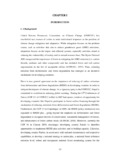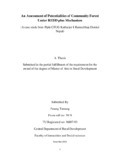Please use this identifier to cite or link to this item:
https://elibrary.tucl.edu.np/handle/123456789/804| Title: | An Assessment of Potentialities of Community Forest under REDD Plus Mechanism (A Case Study From Piple CFUG Katharjor 8 Ramechhap District Nepal) |
| Authors: | Tamang, Pasang |
| Keywords: | Forestry Management;Biophysical;management system;Community Forestry |
| Issue Date: | 2010 |
| Publisher: | Department of Rural Development |
| Institute Name: | Central Department of Rural Development |
| Level: | Masters |
| Abstract: | A study entitled “Potentialities of Community Forestry under Reducing Emissions from Deforestation and forest Degradation (REDD plus) Mechanism” was carried out in Pile CFUG, Kathjor-8, Ramechhap district of Nepal with a view to review policy framework relevant to REDD initiative in Nepal. Similarly, it aimed at assessing the potentiality of REDD in Nepal in terms of biophysical, community forest governance and institutional capacity and existing CF management practices. Different PRA tools like household interview, CFUC meeting, and focus group discussion, review of CFUG constitution & operational Plan, minutes and records were used for primary data collection. Secondary data were collected through reviewing various policies, strategy, guidelines and published & unpublished literatures. The study explicitly shows that CF Policy was previously focused on dealing with local forest dynamics in Nepal but now gradually adapted to international and global demand including climate change. While assessing the bio-physical condition of CF, it illustrates that forest condition has been increased because of community forest management system. Demand status of forest products of local communities is reported larger than supply capacity of CF. The involvement of indigenous people, women and Dalit in decision making in CFUG has been satisfactorily increasing which would be instrumental in enhancing REDD mechanism in Nepal. Benefit sharing mechanism in CFUGs has been guided by the norms developed in group constitution. Earmarking group fund in forest conservation and pro-poor activities may enhance to generate co-benefits of REDD initiatives such as livelihood improvement, improving governance and poverty reduction. Studied CFUG follows CF management practices as indicated in Forest Operational Plan. In this way, community forest has demonstrated good practice of sustainable management forest which is one of the key elements under REDD Plus. A further in-depth study is highly suggested how Nepal’s CF policy and management system adhere to REDD initiative generating mutual climate and community benefits. Before initiation of REDD in Nepal, clarification of carbon ownership particularly in 6 soil carbon should be done. Concrete guideline and mechanism is proposed to establish ensuring equitable benefit sharing to the communities among the users of diverse economic, social and cultural background for diverse management regimes in Nepal. Finally, it is suggested to develop a concrete system on utilizing the REDD fund so as to generate co-benefits from REDD initiative in Nepal. |
| URI: | http://elibrary.tucl.edu.np/handle/123456789/804 |
| Appears in Collections: | Rural Development |
Files in This Item:
| File | Description | Size | Format | |
|---|---|---|---|---|
| CHAPTER(1).pdf | 288.62 kB | Adobe PDF |  View/Open | |
| cover.pdf | 103.07 kB | Adobe PDF |  View/Open |
Items in DSpace are protected by copyright, with all rights reserved, unless otherwise indicated.
